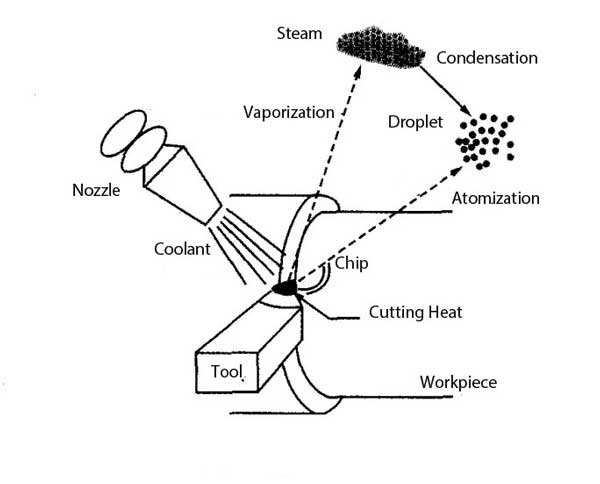Oil Mist Generated in CNC Lathe Processing
During metal processing with CNC lathes, a large amount of cutting fluid is used, leading to the formation of numerous oil mist particles in the air. Metalworking lubricants are complex mixtures that, in addition to hydrocarbons, often contain sulfonates, fatty amines, nitrates, dyes, biocides, and other chemicals. If the lubricant has been in use for some time, due to the oxidation of hydrocarbons, microbial growth, or contamination by external impurities, it may contain additional chemicals that are harmful to both humans and the environment. Therefore, controlling the concentration of oil mist in metalworking workshops is a crucial measure for ensuring occupational safety and health in production enterprises.
1. Formation of Oil Mist
In CNC lathe processing, cutting fluid undergoes processes such as pump circulation, spraying, and intense impact with high-speed rotating tools or workpieces, as well as evaporation at high temperatures. These mechanical, physical, and chemical factors interact, resulting in the generation of significant amounts of oil mist.
Atomization
Mechanical energy converts into surface energy of droplets. This occurs primarily due to the intense impact of the liquid on stationary or rotating components within the CNC lathe, breaking the liquid into fine droplets that remain suspended in the working environment.
Evaporation
The heat generated during CNC machining raises the cutting fluid temperature well above its saturation point. At the solid-liquid contact interface, boiling occurs, producing vapor. This vapor then condenses around small droplets or other particles in the surrounding air, forming oil mist.
2. Classification of Oil Mist
Oil mist is typically categorized into three types:
Mist from spraying and impact, which contains no solid dust.
Smoke from high temperatures caused by evaporation or combustion during high-speed cutting or heating.
Mist with grinding dust generated when cutting fluid is sprayed during grinding processes.
Generally, oil mist from mechanical atomization consists of liquid droplets with a wide range of diameters, typically between 2–10 µm. Vapor-produced oil mist forms very fine condensates during the cooling process, usually with particle diameters smaller than 2 µm.
3. Hazards of Oil Mist
The presence of oil mist significantly increases the risk of fire and slip hazards on oil-covered floors. Additionally, the discharge of oil-laden air from the workshop pollutes the environment.
Moreover, oil mist can adversely affect the health of workers. Prolonged exposure to oil mist from metalworking fluids can lead to diseases, allergic dermatitis, and even malignant tumors, with potential hereditary effects. Medical studies have shown that oil mist particles in droplet form with diameters smaller than 5 µm can reach alveoli in the lungs, where they deposit and cause significant harm. Even at concentrations as low as 0.41–0.55 mg/m³, prolonged exposure can lead to chronic bronchitis, chest discomfort, and respiratory irritation.
4. Oil Mist Treatment
To mitigate the hazards of oil mist, workshops typically adopt measures such as installing exhaust fans, oil mist collectors, and protective enclosures or splash guards around the machines.
Through long-term practice, SMARTLATHE has found that installing oil mist collectors on CNC lathes is the most effective solution. Oil mist collectors can achieve a collection efficiency of over 99% when installed on CNC lathes.
To this end, SMARTLATHE offers high-quality oil mist collectors as optional accessories for CNC lathe purchases. Additionally, installation and commissioning services are provided, ensuring a healthier CNC machining environment.





